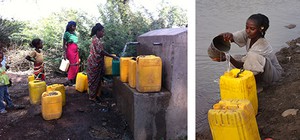Imagine you want to reduce the incidence of diarrhoeal diseases in your locality. You are encouraging people to use a clean water source for drinking (Figure 15.3) instead of using water from a pond (Figure 15.4).

Figure 15.3 (left) Safe water source and Figure 15.4 (right) Unsafe water source.
Listed below are measurements you might obtain. What type of indicator is each one?
- Change in number of people who take water from the new clean water source each day.
- Number of leaflets produced to discourage people from drinking water from the pond, and to raise awareness of the new water supply.
- Number of these leaflets actually distributed.
- Change in number of people collecting water from the pond.
- The incidence of diarrhoeal diseases.
The answers are as follows:
- Outcome indicator: this indicator will tell you if you have succeeded in encouraging more people to use the clean water source.
- Process indicator: this is a measure of the actions you took.
- Output indicator: this measurement will indicate how many people received your leaflet (but it does not tell you if they read it).
- Outcome indicator: this indicator will tell you if you have succeeded in discouraging people from collecting water from the pond.
- Impact indicator: this will measure the long-term result of your campaign. If people are using clean water the incidence of diarrhoeal diseases will go down.